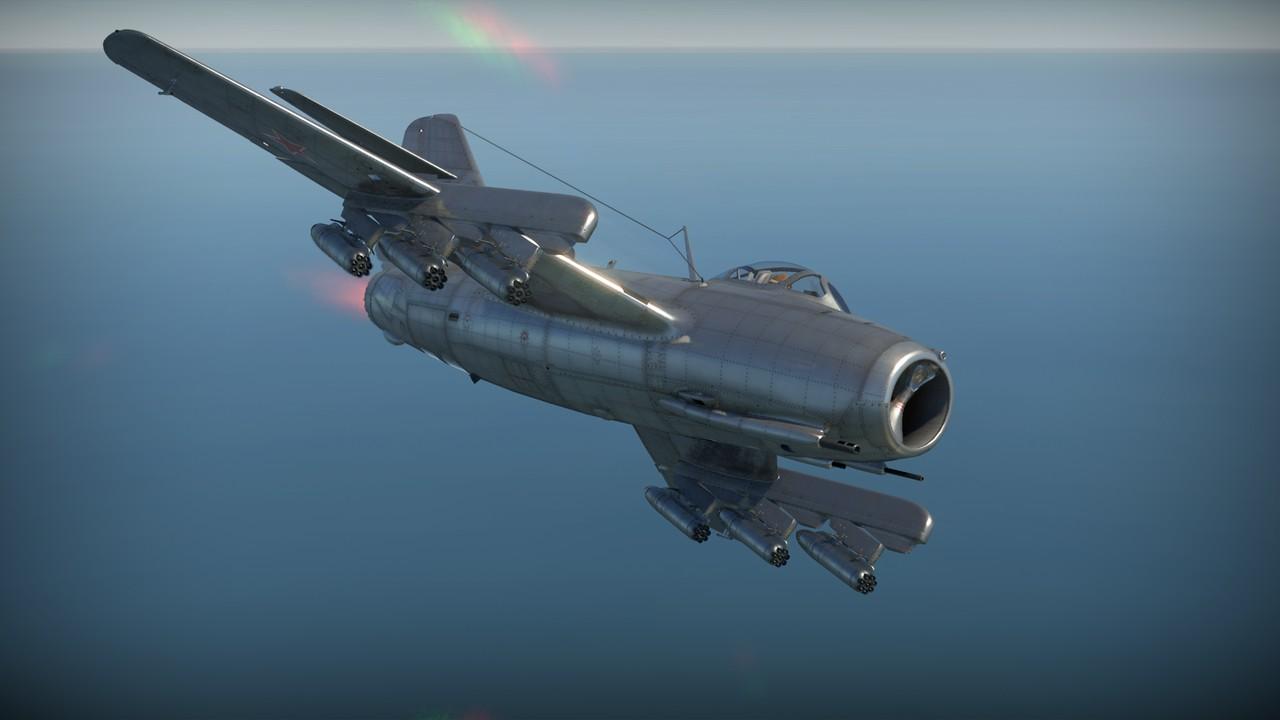
These views of the MiG-15bis (ISh) in happier times
when it was safely tucked away in a hangar show the triple-tandem weapons racks
on each mega-pylon; these could be angled down 15 degrees, allowing six FFAR
pods to fire at once when the aircraft was in level flight. Note also how the
top of the pylon passes over the top of the wing.
After World War II was over, the leaders of the USSR
realized that they were behind the leading states of the world in the sphere of
jet aircraft construction, most notably in the full-scale production of
turbojet engines. Consequently, a delegation including the designers A. I.
Mikoyan and V. Y. Klimov was sent to Great Britain towards the end of 1946.
Their negotiations were successful, resulting in the purchase of two of the
most advanced turbojet engines at that time: the Rolls-Royce Derwent Mk.V and
the Rolls-Royce Nene I/Nene II. The British consented to sell their newest
strategic designs easily enough, since they believed that the Soviet
industrial/technological apparatus could not handle the mass production of
sophisticated assemblies. However, very soon that the Rolls-Royce engines were
launched into full-scale Soviet production under the designations RD-500 and
RD-45.
The emergence of the new engines led to the creation of
Soviet jet fighters able to compete with the leading models of the world. In
1947, the Mikoyan Design Bureau started the development of a front line fighter
with a Nene (RD-45) turbojet engine and an airtight cockpit: the I-310
(“”S””). The first S-01 prototype aircraft made its first
flight on December 30, 1947, and, after working on the test results, was
launched into full-scale production in 1948 under the designation MiG-15. The
plane’s airframe was an all-metal monoplane configuration with mid-swept wings
and empennage. Thus the MiG-15 became the first production swept-wing fighter.
The MiG-15 was equipped with a RD-45F single-shaft turbojet engine
rated at 2,270 kg of thrust with a double-entry centrifugal compressor. The
plane’s armament included a 37mm Nudelman N-37D cannon with 40 rounds and two
23mm Nudelman-Suranov NS-23KM guns with 160 rounds in total. The cannons were
mounted in the forward fuselage on a lowerable carriage. Two 100-kg or 50-kg
bombs could be suspended under the wings. To increase its flight range, the
aircraft could carry two external fuel tanks with a capacity ranging from 250
to 600 liters.
The MiG-15 fighter was notable for its simple and reliable
structure, high flight and operating characteristics, and powerful armament.
Its maximum speed, rate of climb, ceiling, and flight range were the best among
Soviet fighters at the time and superior to many foreign aircraft, as well.
The first production MiG-15s with RD-45F engines began to
leave the factory floor in early 1949. In 1950, more advanced MiG-15bis
fighters replaced them in the factory assembly lines
A fighter-bomber conversion of the MiG-15bis, designated
ISh (Istrebitel-Shturmovik).
One of the most distinctive trials modifications was the
“MiG-15bis-ISh” ground-attack aircraft, which featured a modified
wing sporting large “beams” that were used to carry ordnance. About
twelve were built, but since the rival Sukhoi OKB was developing dedicated
ground attack aircraft at the time, the MiG concept went no further.
In an attempt to enhance the combat potential of the
MiG-15bis, the Air Force’s Aircraft Operations and Repair Research Institute
developed a specialized attack version from 1958 to 1964. The aircraft was
designated MiG-15bis (ISh), the suffix standing for istrebitel’-shtoor- movik
(fighter/ attack aircraft).
The MiG-15bis had reinforced wing spars and huge weapons
pylons extending far beyond the wing leading edge, about halfway between the
main gear units and the drop tank attachment points. These were fitted with
triple weapons racks located in line, permitting the carriage of three 50- to
100-kg bombs, FFAR pods, or heavy unguided rockets under each wing.
An experimental batch of 12 air- craft was built; some
sources, though, quote a much lower figure (three flying prototypes and a
static test airframe). One of them survives at the Russian Air Force Museum in
Monino, east of Moscow.
Offensive armament
The MiG-15bis ISh is outfitted with the following offensive
weapons:
1 x 37 mm N-37D
cannon with 40 RPG.
2 x 23 mm NS-23
cannons with 80 RPG (160 total rounds)
The MiG 15 bis IShs carries multiple offensive weapons which
consist of two 20 mm cannons and a 37 mm cannon. There is limited ammo on both,
so eliminate enemies on the first pass if possible.
The MiG-15bis ISh can be outfitted with the following
ordnance:
without load
6 x 100 kg OFAB-100 bombs (600 kg total)
4 x 250 kg
OFAB-250-270 bombs (1,000 kg total)
2 x 500 kg
FAB-500M-54 bombs (1,000 kg total)
8 x S-1of rockets
48 x S-5K rockets
48 x S-5M rockets
The MiG benefits from multiple mounted weapons, consisting
of six x 100 kg bombs, four x 250 kg bombs, two x 500 kg bombs or 8 x S-1 or 48
x S-5K/S-5M rockets, mounted inside two external mounted pods. Note that the
pods are mounted at a downward-facing angle. This aircraft carries no
air-to-air weapons nor any type of decoy munitions.